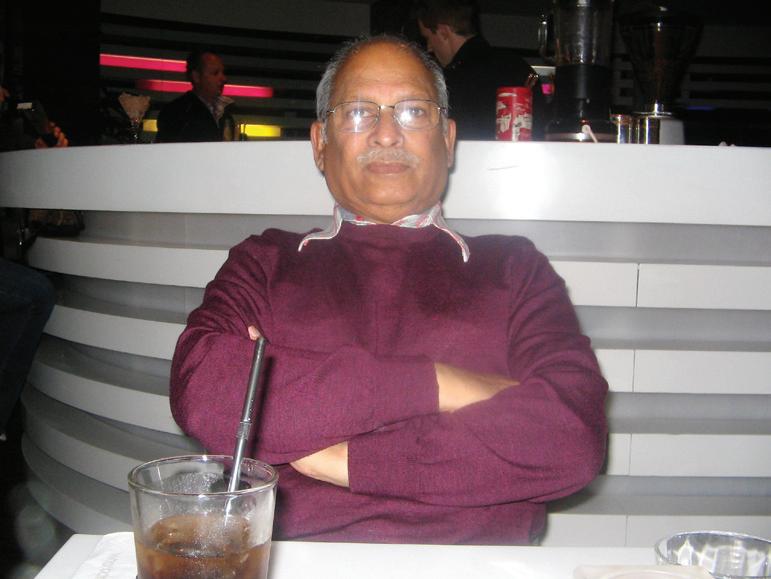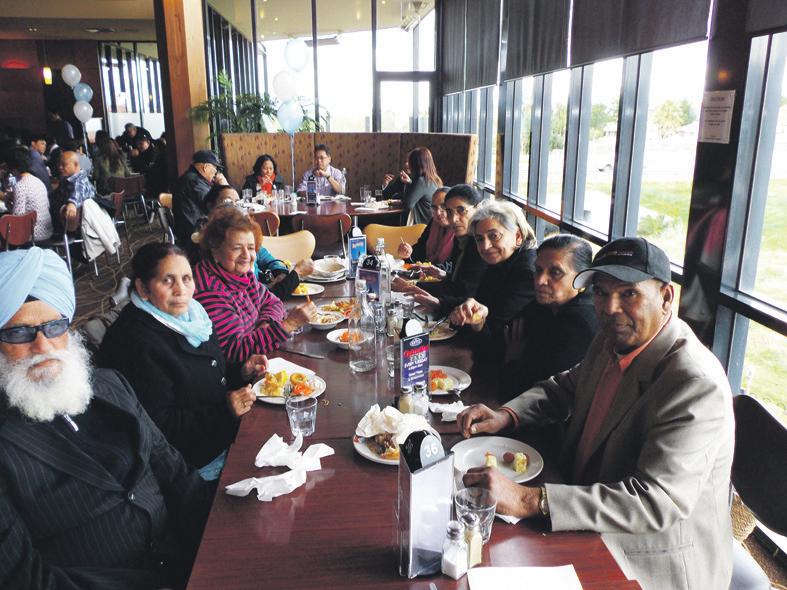
8 minute read
The Senior Scene
from 2013-09 Melbourne
by Indian Link
held its Annual General Meeting paid members attending. To commemorate India’s 66th Independence Day, President Mona Raju asked us to stand up, place our right hands over our chests in a USA-style salute, and sing the Indian national anthem. The performance ended with loud chants of Jai Hind. Some Fiji enthusiasts even chanted Jai Fiji! Barbara Nagaya, the new elected President, thanked the outgoing Committee and welcomed new and old members alike. Vice President Raj Babbar assured members that under Barbara’s guidance, he would do all he can for KISCA members.
“Barbara or Babbar,” punned Raj, “we both mean to serve”. Mona Raju is the new Secretary, Ratan Moolchandani the Treasurer, and Kiran Bedi, Rita Aggarwal, and Vishnu Prasad Committee members. President Nagaya may be contacted on 03 9893 3427.
Indian Senior Citizens Association (ISCA)
celebrated the annual Multicultural Day recently, with members turning up at the venue despite tickets being on sale since July. Members interacted and shared their thoughts with Anna Burke, Speaker of the Federal House of Representatives; and Mr John Nguyen, the aspirant candidate who is challenging the Speaker in her constituency. Alan Griffin MP, arrived a bit late. Michael Gidley, the local MP, also praised ISCA’s efforts. Cr. Robert Davis; Mr Emanuele Cicchiello, aspirant candidate from Bruce constituency; and VMC Chief Chin Tan were also present. Mr Srinivasan, VMC Commissioner for the Indian community praised Chinese participation in an Indian function as “a great example of the India and China friendship”.
President Prem Phakey welcomed the honourable guests, members and artists who were to perform on the day. Prem acknowledged VMC grants for various functions such as Diwali and Christmas, and the current Multicultural Day. Ms Burke, in her intimate style, appreciated the community’s efforts at maintaining their culture via these events. She also referred to a journalist from the Hindustan Times who attended a Federal Parliament session and reported on the event back at home in an unbiased manner. Alan Griffin mentioned the unique message of the ISCA motto: Friendship and Mutual Help, besides two hands clasped in a friendly shake, which Shano Rajkumar created some dozen years ago as first editor of the ISCA’s newsletter. Alan also praised the ISCA banner, the product of Shano’s imagination and intellect. Alan also shot a comment, to everyone’s delight and muffled laughter, that while he himself was getting older, “You Indians are looking younger and younger!” Elegantly dressed as always, Srini Srinivasan was his usual friendly self.
On concluding housekeeping issues, Prem reminded members to fill in forms for positions or recommendations on ISCA’s Working Committee. Next, Prem introduced Mr Sunder Shivdasani, Returning Officer for the AGM, who advised that it will be held at the usual Mt. Waverley Hall venue.
Mr and Mrs Krihan Lal Bagga were congratulated for celebrating their 50th wedding anniversary on the day. The 14 September meeting will be held as scheduled. Jasbir Bedi invited a group of six colourfully attired dancers in silken costumes and ribbons from Monash Chinese Friendship Association, who performed a sublime dance on pre-recorded music, to great applause. Now came the heartbeat of the day, when Chinese origin Niu Zhiguo sang, Awaara Hoon. Ya gardish men hoon aasmaan katara hoon, from Raj Kapoor’s Awaara (1952). He sang in Mandarin of course, but to the original music, and the applause seem never-ending. He also sang another number in Mandarin in his clear voice.
Now came young Vidarshana
(15), and the Anand sisters Chandana (15) and Yogita (just 5), all students learning Bharatnatyam at the Vignyaasa School of Indian Dances. They performed a dance with mastery of movement. The Chinese group returned to perform another dance, while the Indonesian dance troupe sent in their apologies. Lunch from Tandoori Junction was delicious and enjoyed by all. For more information, please call President Phakey on 03 9803 3989.
The Indian Senior Forum (ISF) commemorated India’s Independence Day by making their meeting a colourful musical event. 60 plus members came dressed in colours of the Indian flag and filled the room with saffron, white and lush greens. The day started off with the National Anthem and was followed by some of India’s most patriotic songs. The members then participated in an interactive quiz on Independence Day. In fact, each senior remembered the independence movement so clearly that it transformed from a quiz to a reminiscing activity. Finally, on a lighter note, members enjoyed participating in a Bollywood quiz on patriotic songs. The day ended with a reflection on our adopted country’s history as well, and what it meant to be an Australian Indian. With similar passion and fervour, many members individually described what it meant to them to be Australian. One member detailed the history of Australia and the journey of Australia’s independence. Indian seniors celebrated their culture, identity and country on this fun-filled day of activities, reflection and celebration. These forums take pleasure in preventing social isolation of the elderly and giving them a sense of togetherness and belonging.
On September 22, the forum is organising a bus trip to Geelong. For more details contact Mr SK Auplish on 03 9561 1878.
The adorable Krishna
In a recently held music program, the Shiamak Indian Music and Dance Group invited Mrs Krishna Arora and asked her to dance on the stage at their event. Forever obliging, Krishna agreed and despite her ripe age, readily danced to everyone’s delight. Cat whistles accompanied worded accolades. At the end of the show, the group presented Krishna with a trophy titled ‘Shiamak Star’, for being the oldest dancer on their stage and for being such a great sport. Bollywood choreographer and dancer Shiamak Davar has three branches of the school in Melbourne.
Indian Seniors Association - West

(ISAW) celebrated India’s 66th Independence Day by taking its members to Water Gardens Hotel in Taylor’s Lakes for a grand buffet lunch. Both the ambience and the food were excellent, as members expected, and everybody had a truly great time.
For more information on ISAW’s program, please call President Arjan Tuli on 03 9390 2818.

What’s dragging rupee down: Speculation or economics?
What’s fuelling the persistent fall in the value of the Indian rupee? According to experts, there are several reasons. But most of them feel the bottom is yet to be tested.
The rupee, which was valued at around 55 to a US dollar in January, now trades as much as 18% lower at 65 to the greenback. Against the British pound sterling, it has breached the 100-mark. Each passing day is seeing a new low.
The Indian currency depreciated almost five percent this month.
Some analysts feel the currency has weakened due to structural problems in the economy and the trend would continue if they were not addressed urgently. Others maintain the recent volatility is more due to speculations and external factors.
“The decline is not just because of psychological factors alone,” said Anis Chakravarty, senior director, Deloitte in India. “This is hard economics,” Chakravarty told IANS.
He said structural problems in the Indian economy are impacting investment and growth and must be addressed urgently to ensure stability in the currency and equity markets.
“There are issues with the Indian economy that need to be addressed”.
He pointed out that India’s current account deficit - which is the difference between the total imports and exports of goods and services, and also inward and outward money transfers - jumped more than 10 times in five years.
In other words, a net amount of $90 billion equivalent went out of India in 201213, as against $8 billion in 2007-08, putting much pressure on the country’s foreign exchange reserves that is generally used by central banks to keep currency markets stable.
Equated to the gross domestic product, the deficit touched a record of 4.8%.
“Foreign funds have withdrawn significant amount of money out of Indian markets in the past couple of months. The trend continued during August. It is evident that alarmingly high levels of current account deficit have been core to this slide,” Chakravarty said.
Finance Minister P. Chidambaram said the rupee is undervalued and has overshot its reasonable limit due to “unwarranted pessimism” in the markets.
Some analysts also see the recent volatility as a result of speculation. “It is more of hype and overdone,” says Siddharth Shankar, advisor at brokerage firm KASSA.
“There was no such economic development in the past couple of months to justify this volatility”.
According to Deutsche Bank and several think tanks and analysts, the rupee will soon touch a new low.
“We now believe the rupee could touch 70 to the US dollar in a month or so, although we expect some revival by the end of the year,” the German bank said in a report.
Shankar, referring to the Deutsche Bank report, said such statements only add to the volatility that affects the economy.
“No doubt, there are problems with the Indian economy - growth is low, current account deficit is high. But these things have not come about in the last one or two months. They have been there for a couple of years,” he said.
India’s economic growth slumped to five percent in the financial year ended March 31, 2013. And according to Shankar, growth was likely to remain below five percent in the current fiscal as well.
Dinesh Thakkar, chairman and managing director of Angel Broking, said the Indian rupee was slipping due to both weak domestic and international factors.
“We expect the depreciation in the rupee to continue until the Indian economic scenario stabilises and when the world markets absorb the impact of the quantitative easing of stimulus process by the US Federal Reserve,” Thakkar told IANS.
The US Federal Reserve recently indicated that it may resort to quantitative easing by trimming the $85-billion-a-month debt purchases later this year and eventually end it by next year if the economy performs in line with estimates and the job situation improves.
These comments led to a broad rally in the dollar, while currencies of other emerging markets, including Indonesia, Malaysia and Thailand hit multi-year lows.
But the Indian rupee was the worst hit. It has depreciated more than 15% in three months.
Foreign funds have also sold over $11.5 billion of Indian debt and equities since the Fed hinted at cutting the stimulus in late May.
Trimming of stimulus by the US may lead to further outflow from India’s equity and debt markets and put more pressure on the current account deficit - and ultimately the rupee. A foreign exchange reserve of $275 billion could prove little to stave it off.
Now, Chennai autos GPS-fitted, costlier
In a first-of-its-kind development in the country, auto-rickshaws in Chennai will be fitted with a meter with global positioning system (GPS) and electronic digital printer, Tamil Nadu Chief Minister J. Jayalalithaa said recently.
In a statement issued revising the tariff for auto-rickshaws, Jayalalithaa said: “For the first time in India, auto-rickshaws plying in Chennai will be fitted with GPS and electronic digital printer, free of cost, by the government, involving an outlay of Rs.80 crore”.
She said the travelling public will be given a receipt with the distance travelled and the tariff rate.
“The operation of the auto-rickshaws will also be monitored effectively,” she added. The meter, the chief minister explained, will also have a ‘panic button’ so that a passenger can press it in case of any danger. The device enables monitoring by a control centre.
She said the government has fixed the minimum tariff rate at Rs.25 for the first 1.8 km and Rs.12 for every additional km. For night travel (between 10 p.m. and 5.a.m.), the tariff will be higher by 50 percent.
The waiting charges will be Rs.3.50 per five minutes, and Rs.42 per hour.










